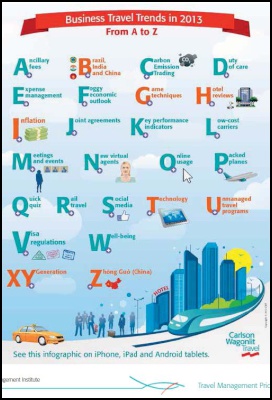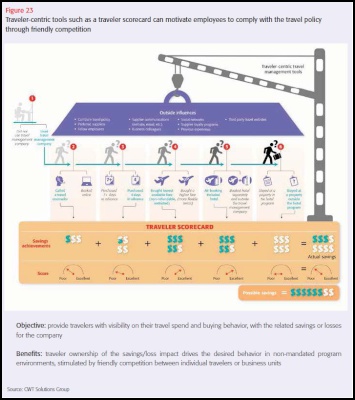CWT launches 2013 Travel Management Priorities report
Key Findings:
News Release
CWT Travel
Manager Survey Shows Cost Control Continues to Drive Buyer
Behaviour
CWT report highlights travel
buyers’ priorities are identical regardless of company
size, industry type, travel spend or program scope
SYDNEY January 25 – CWT
today published its CWT Travel Management Priorities
report based on an international survey of nearly 800 travel
managers. The scope of the survey includes companies with
mid-sized national programs and an annual travel spend in
the range of US$2 million as well as companies with large,
international travel programs with an annual travel spend of
more than US$100 million.
Travel managers concentrate efforts on
further savings
The report shows that the
overall ranking of priorities for 2013 remains very similar
to the order of priorities for 2012. Travel buyers intend to
focus on areas representing the greatest savings
opportunities rather than those associated with the
traveller experience. This is true regardless of the size of
the company, the industry type, the budget spent on travel
or the scope of the travel program.
“The challenging economic climate means that there is continued pressure on buyers to both reduce costs and manage travel in a more cost-effective way,” commented Christophe Renard, CWT vice president marketing, communications and business intelligence. “As air and ground travel represents the majority of spend within a travel program, it is not surprising that it is the number one priority for most travel buyers, even though it is an area that is already well advanced in terms of optimisation.”
The measures that travel managers plan to take to achieve these objectives vary according to region. While North American travel buyers are aiming to further consolidate their programs and standardise processes, their counterparts in Asia-Pacific are intending to focus more on improving travel compliance and mandating preferred booking channels; Latin American travel buyers are concentrating on implementing advanced booking rules and strengthening car rental policies, whereas travel buyers from Europe, the Middle East and Africa are tightening air and rail policies to drive down air and ground costs.
Travel buyers with global responsibility are the only category of buyers to tackle traveller compliance with technology 2.0. Their top three actions to achieve this target include offering mobile services to travellers, implementing a social media tool or apps and providing their travellers with a web-based traveller portal. To achieve the same objective, regional travel buyers are looking at more traditional actions such as communication and training on policy.
“Travel managers with a global scope are more likely to test new procedures and techniques. They tend to be very advanced in optimising their travel programs and as a result, they are often looking to address new challenges with innovative methods,” continued Renard.
Business
travel trends indicate the challenges for 2013
The second part of the report covers the
Business Travel Trends for 2013 and digs into the
changes that travel buyers are likely to see over the year
and the challenges they will be faced with in the current
economic climate and evolving business travel landscape.
From a pricing perspective it is likely that global inflation will hit travel prices modestly overall, with increases of under 5 percent; in addition, travel managers will need to monitor programs and suppliers closely, paying particular attention to areas such as rising ancillary fees and fuel surcharges.
Changes in technology will
affect the travel process with consumer-influenced
technology increasingly finding its way into corporate
travel through services such as travel review sites and
mobile apps specifically designed for business travellers.
Travel management 2.0 will also be a major theme in 2013 as companies seek to find the right balance between exercising the right level of control over traveller booking behaviours while ensuring that travel is still “managed” for budgetary, and safety and security reasons.
Finally, risk management will also play a key role as companies send travellers to increasingly high risk areas and duty of care during business travel becomes an integral part of a company’s legal responsibility to its employees.
Read the full report here.
Associated resources
CWT Travel
Management Institute Mastering the Maze: A Practical Guide to Air
and Ground Savings
###
About Carlson Wagonlit Travel
CWT is a global leader specialised in managing business
travel and meetings and events. CWT serves companies,
government institutions and non-governmental organisations
of all sizes in more than 150 countries and territories. By
leveraging both the expertise of its people and leading-edge
technology, CWT helps clients derive the greatest value from
their travel program in terms of savings, service, security
and sustainability. The company is also committed to
providing best-in-class service and assistance to
travellers. CWT services and solutions comprise Traveller &
Transaction Services, Program Optimisation, Safety &
Security, Meetings & Events and Energy Services. In 2011,
sales volume for wholly owned operations and joint ventures
totalled US$28.0 billion. As part of its commitment to
responsible business, CWT is a signatory of the United
Nations Global Compact Ten Principles. For more information
about CWT, please visit our global website at www.carlsonwagonlit.com. Follow us
on Twitter @CarlsonWagonlit.

Click for big version.
Business Travel Trends A-Z 2013

Click for big version.
Traveller Scorecard 2013

Click for big version.
2013 KEY
PRIORITIES
1. The #1
priority for travel managers in the APAC region is
improving traveller compliance, pushing air
and ground savings to 2nd place (Pg.
10-11)
2. Air and ground
savings
3. Hotel
savings
KEY BUSINESS TRAVEL
TRENDS
• Australian business travel
spend is expected to grow by 4.6% in 2013 (Pg. 36)
•
Air ticket prices should increase by approx. 2.5% in APAC
(Pg. 41)
• Average daily hotel rates will
likely increase by approx. 3.5% in APAC (Pg. 41)
•
Meetings and events spending is likely to increase by 6% in
APAC (Pg. 41)
• Low cost carriers (LCCs) will
be used increasingly by business travellers in 2013. In
2012, the APAC region had a 24.1% share of capacity, up 5
percentage points from 2011 (Pg. 49)
• Car
rental rates in APAC will likely experience the world’s
highest inflation, with a 5.9% increase in 2013. Rates in
Australia and NZ will rise sharply due to increased demand
and more tightly managed fleets (Pg. 41)
SOCIAL
MEDIA & GEN Y
• Travel managers in
APAC are adopting social media at a quicker pace compared to
other regions (32% compared to 28% in North America, 32% in
Europe, Middle East and Africa, and 14 % in Latin America).
- Qantas has adapted to this trend, using Facebook
and Twitter to communicate with passengers during crises
(Pg. 61)
• Gen Y is emerging as the new breed
of travellers who are social by nature, mobile and keen to
manage their travel expenses on the go. This has
implications on travel management programs that increasingly
need to reflect customisation and the introduction of new
apps and services (Pg.
70)
ENDS


 Bill Bennett: Download Weekly - One NZ chooses Ericsson for core network update
Bill Bennett: Download Weekly - One NZ chooses Ericsson for core network update Mountains to Sea Conservation Trust: Orange Roughy Leads The Pack As Fish Of The Year Heats Up
Mountains to Sea Conservation Trust: Orange Roughy Leads The Pack As Fish Of The Year Heats Up Hugh Grant: Retail Crime Is Out Of Control – Why Business Owners Can’t Wait For Government Action
Hugh Grant: Retail Crime Is Out Of Control – Why Business Owners Can’t Wait For Government Action SkyCity Auckland: Sky Tower Glows For International Women’s Day
SkyCity Auckland: Sky Tower Glows For International Women’s Day E tū: Deep Concerns About Undue Influence At NZME
E tū: Deep Concerns About Undue Influence At NZME Air New Zealand: Air New Zealand Chief Executive Greg Foran To Step Down In October 2025
Air New Zealand: Air New Zealand Chief Executive Greg Foran To Step Down In October 2025



